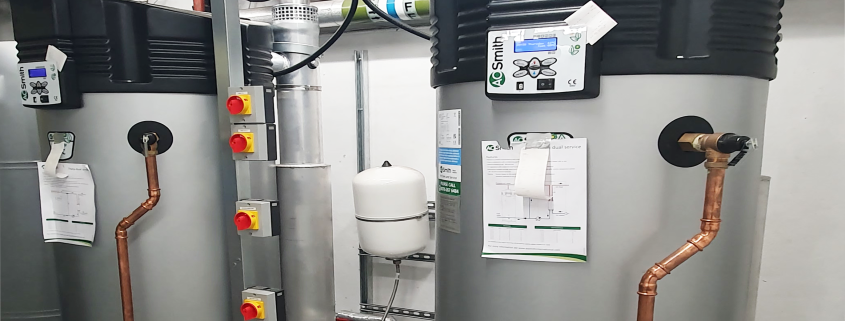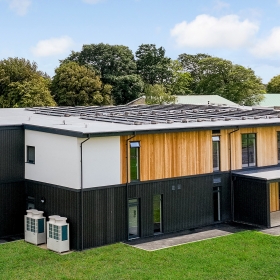Unlocking sustainability in school buildings
Greg Brushett, sales director at commercial hot water specialist Adveco, considers the current and potential options schools can take advantage of to support the decarbonisation of the built estate…
In the UK, the School Premises (England) Regulations 2012 require schools to have “an adequate supply of hot and cold water” in toilets and washing facilities, unfortunately, the production of hot water alone can drive as much as 30% of a building’s daily energy demands. Given space heating and water heating in buildings account for as much as 50% of the UK’s annual carbon emission implementing sustainable water heating, as it is a necessity, is one of the quickest and most direct methods for achieving measurable carbon reduction.
As hot water can be treated as a separate system it does not require the larger scale, costly renovations associated with space heating. This means schools can begin to make changes to current operations that immediately help to fulfil the demands of the Public Services (Social Value) Act. At its simplest, the government drive is to move buildings off gas and over to electricity. New build projects, unless exhibiting very large hot water demands which can often be found in school buildings, will struggle to receive permission (under Part L of the building regulations) for a new gas connection and as a result will specify electric-based systems.
Continued use of gas, remains a grey area. Whilst not a sustainable option, it remains a cost-effective pathway to a future green gas strategy. Here in the UK, the status of hydrogen remains to be confirmed. The Heating and Buildings Strategy published in late 2021 did however begin to indicate the growing support for the technology. The implication for schools is, if you currently use gas, then you can upgrade to new high-efficiency gas appliances up until 2035. However, the EU states are pressing for all publicly owned buildings ‘in scope’ to have zero on-site emissions derived from fossil fuels from the beginning of 2028. If that happens then the UK may be pressured to follow suit. If, from 2026, UK policy does support the adoption of hydrogen then the path should remain clear for education projects looking at unlocking the potential of hydrogen as one of the most cost-effective options for achieving net zero.
Currently, government policy promotes the adoption of heat pumps, with the easiest to install and most cost-effective being air source heat pumps (ASHP). But this is a technology that operates most efficiently at lower temperatures, at odds with school hot water systems which require a 60°C+ working flow for safe operation and anti-legionella processes. A heat pump can however be pushed to deliver a higher percentage contribution, generating working temperatures of 45-50°C for preheating, but this at the cost of performance efficiency, requires electrical energy, and that again has operating cost implications. To accommodate this the simplest approach blends the ASHP preheat with an electric boiler supplying thermal energy to a mains water-fed compact indirect cylinder.
Compared to an equivalent-sized direct-electric (i.e., from the grid) system, one with an ASHP can achieve carbon reductions of 42-47%, whilst saving 25-35% of the energy costs. With the heat pump’s reduced operational efficiency, it will still be much more expensive to run than an equivalent-sized gas-fired system. The recommendation in this case is to keep electrical demand down by increasing the size of the hot water storage which is then heated more slowly, very different to the high energy input and low storage seen with gas-fired systems.
Further efforts to improve heat pump efficiency today can also be gained by specifying solar thermal collectors alongside the ASHP to guarantee the preheat temperature. Requiring a minimum three-metre drop to ensure flow does mean solar thermal is only suited to installation on a building, but properties with larger unobstructed flat or sloped roofs, such as schools, are perfect for locating solar thermal collectors. Not to be confused with electricity-generating solar photovoltaic (PV), solar thermal is a fluid-based system that transfers solar energy via indirect heating in the cylinder into the hot water system. The design of the system allows for the heat pump to contribute to the incoming cold water. That ensures 45°C while taking advantage of the coefficient of performance (COP) of the heat pump. The solar thermal is then employed after the heat pump to heat the water from 45°to between 50°C and 60°C depending on the time of year.
Sized and installed correctly, a single solar thermal collector can contribute up to 1400kWh per annum, providing electricity savings of £300 and more importantly reducing emissions of CO² by 322kg. Whilst solar thermal can be deployed in isolation, by delivering hybrid preheat through both the ASHP and solar thermal system, demands on more costly electric heating are considerably reduced, if not avoided entirely. Given the current costs of electricity, solar thermal now offers a relatively fast return on investment and, since it is a capital expenditure it can, like the ASHP, contribute to positive sustainability reporting.




Leave a Reply
Want to join the discussion?Feel free to contribute!